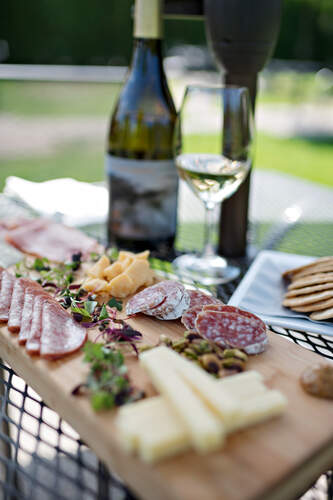PAIRING LIGHTER REDS, WHITES AND ROSÉS
With warm weather on the horizon some of our palates take a turn from sipping on big and bold wines and begin reaching for lighter-bodied red, white, and rosé wine. In general, lighter-bodied wines are lower in sugar, alcohol, and tannin and higher in acidity. Pairing lighter-bodied wines with food can be simple once you understand a wine’s structure.
So, let’s look at what makes up the structure of a wine. The main natural and structural components found in wine are sugar, acid, alcohol, and tannin.
Sugar or residual sugar (what’s left in the wine after fermentation) will add body and weight to a wine. In lighter-styled wines the sugar is fermented out to dryness.
Alcohol adds body and weight to a wine. It gives the palate a weightier mouth-fill along with creating a warming sensation. Lower alcohol wines are similar in feel to skim milk while higher alcohol wines feel more like cream.
Tannin presents itself as a drying sensation and adds structure, texture and complexity to the wine. In these lighter-bodied wines tannin will only be noticeable in reds. Two types of tannins exist – grape tannins, which are found in grape skins, seeds, and stems; and wood tannins, which are found in the oak used to age or store the wine (chips, staves or barrels). Grape tannins tend to be perceived as less bitter and drying than wood tannins.
The final component is acid. Ever wonder why a glass of lemonade in the summer heat hits the spot? It’s the tartness (acidity) that makes your mouth water and lures you subconsciously to take another sip, all the while seamlessly quenching your thirst. It’s also responsible for the zippy and refreshing aspects in many wines.
So now how do we use this newfound knowledge to pair wines?
When creating food and wine pairings an easy tip is to only focus on one or two of the main structural components in the wine. Below are some food pairing suggestions for these lighter-body styled wines that would be great for any of your warmer weather gatherings.

Pairing #1
2020 Stratos
In rich and salty dishes such as shellfish, deep fried foods, and dishes with creamy or butter-based sauces, a high-acid white wine is just the ticket because the high acidity will cut though a dish and temper the richness and/or brininess of the food.
Pairing #2
2019 Riesling
Tandoori-style Shrimp and other semi-spicy dishes go hand-in-hand with a dry to off-dry, lower-alcohol wine. The almost undetectable amount of residual sugar as well as the lower alcohol helps soften the spicy heat of the dish.
PAIRING #3
2019 Viognier
Although our Viognier is technically a dry wine it has an abundance of vibrant fruit characteristics and floral aromatics that fool our senses in to thinking it has sugar sweetness. With that in mind, you can pair food similar in flavor to the wine. A crostini covered in a soft cheese such as ricotta combined with roasted peaches and crushed marcona almonds is the perfect combination.
PAIRING #4
2019 Grenache
Our Grenache has more grape tannins than wood tannins so instead of reaching for a heavily charred steak, grill a burger with a gorgeous slice of sharp cheddar cheese. The meat and cheese provide just the right amount of protein that the lighter tannins in the wine work well with.
Remember, there are no set rules in food and wine pairing, only guidelines to lend a hand. The best way to figure out what your tastes are is to experiment. When you are ready to try your hand at some of your own pairings, we've got you covered. Through June 30th, ground shipping is included in orders of $200 or more. Enjoy the journey!
Cheers and enjoy!
- Shelly Fitzgerald, Wine Education Specialist, CS, CSW, AWE, WSET Level 3